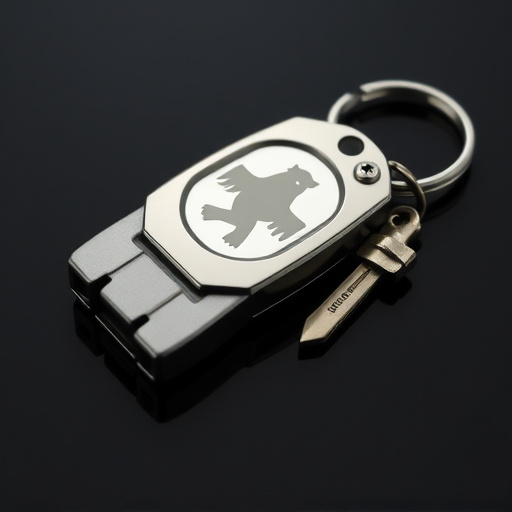Metal keychain self-defense tools, made of sturdy materials like steel or aluminum, offer a portable option for personal safety. Featuring sharp blades or points and non-lethal force options, they provide deterrence in emergencies. When choosing one, prioritize an easy-to-use locking mechanism and secure grip for control. Training is essential to ensure effective and safe deployment while understanding local laws regarding their use is crucial to avoid legal issues and promote responsible self-defense.
In today’s world, personal safety is paramount. One compact solution gaining traction is the portable keychain weapon, a discrete metal keychain self-defense tool designed for emergency situations. This article explores the safety features crucial for such devices, including durable construction, sharp points, and easy deployment mechanisms. We’ll delve into effective use, training considerations, and legal implications, equipping folks with knowledge to make informed decisions about their safety while promoting responsible usage of these metal keychain self-defense tools.
- Understanding Metal Keychain Self-Defense Tools
- Safety Features to Look for in Keychain Weapons
- Effective Use and Training Considerations
- Legal Implications and Personal Responsibility
Understanding Metal Keychain Self-Defense Tools
Metal keychain self-defense tools have emerged as a convenient and portable option for personal safety. These compact devices are designed to be easily carried on keys, allowing users to defend themselves in various situations. Crafted from robust metals like steel or aluminum, these tools boast sharp blades or sturdy points that can deter attackers and provide a sense of security.
Understanding the mechanics and safety features of metal keychain self-defense tools is paramount. Some models feature locking mechanisms to prevent accidental deployment, ensuring the tool remains secure until needed. Ergonomic designs offer better control and maneuverability during use. Additionally, certain keychains incorporate non-lethal force options like pepper spray or noise makers for added protection without causing permanent harm.
Safety Features to Look for in Keychain Weapons
When considering a metal keychain self-defense tool, safety should be your top priority. Look for features that ensure responsible use and minimize risk to yourself and others. One crucial aspect is a simple yet effective locking mechanism. This prevents accidental deployment and keeps the tool secure when not in use. Additionally, search for models with a non-slip grip, ensuring you have a solid hold during emergency situations.
Another important safety feature is a built-in safety strap or lanyard. This allows you to attach the keychain weapon to your wrist or clothing, reducing the chances of it slipping from your grasp during a struggle. These features, combined with proper training and awareness, can help ensure that a metal keychain self-defense tool serves its purpose while maintaining safety as a paramount concern.
Effective Use and Training Considerations
A metal keychain self-defense tool, while compact and convenient, requires proper training to ensure effective and safe use. Effective deployment depends on understanding your surroundings, assessing threats, and reacting swiftly. Training should cover basic hand-to-hand combat techniques, focusing on strikes and blocks that can be executed in tight spaces. Practice drills that simulate real-life scenarios, enhancing your ability to remain calm under pressure.
Considerations for training include familiarizing yourself with the tool’s range and limitations. Different keychain weapons have varying reach and stun capabilities, so knowing their effective distance is crucial. Additionally, learn proper grip techniques to maximize control and minimize injury risk, both to yourself and others. Regular practice sessions will build confidence and muscle memory, ensuring you can react instinctively in potentially dangerous situations.
Legal Implications and Personal Responsibility
When carrying a metal keychain self-defense tool, it’s crucial to understand the legal implications and personal responsibilities associated with such a decision. Laws regarding self-defense tools vary greatly from one jurisdiction to another. In some places, small, portable defense devices are explicitly allowed for personal protection, while others may have stringent regulations or outright bans on certain types of weapons, even if they’re designed for self-defense. It’s essential to research and comply with local laws to avoid legal consequences.
Personal responsibility is equally important. Carrying a metal keychain self-defense tool comes with the duty to use it responsibly and only in situations where it’s necessary to protect oneself or others from imminent harm. This means understanding when de-escalation methods are appropriate and when the use of force is justified. Misusing such a device could lead to severe legal repercussions and potentially cause harm to innocent parties, shifting the responsibility onto the carrier.
Portable keychain weapons, while offering convenient self-defense options, require careful consideration. When choosing a metal keychain self-defense tool, prioritize safety features such as durable construction, sharp and reliable blades, and ergonomic designs. Proper training and understanding of legal implications are paramount to responsible use. Always stay informed about local laws regarding personal defense tools, and remember that effective deployment comes with practice. By adhering to these guidelines, you can ensure the safe and responsible carrying of a metal keychain self-defense tool.
